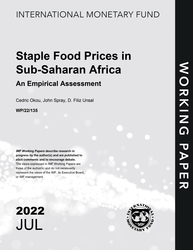
Staple Food Prices in Sub-Saharan Africa: An Empirical Assessment
Staple Food Prices in Sub-Saharan Africa: An Empirical Assessment
READ MORE...
Volume/Issue:
Volume 2022
Issue 135
Publication date: July 2022
ISBN: 9798400216190
$20.00
Add to Cart by clicking price of the language and format you'd like to purchase
Available Languages and Formats
| English |
Prices in red indicate formats that are not yet available but are forthcoming.
Topics covered in this book
This title contains information about the following subjects.
Click on a subject if you would like to see other titles with the same subjects.
Exports and Imports , Inflation , Economics- Macroeconomics , Economics / General , Food prices , inflation , food insecurity , disasters , wars , monetary policy framework , food price inflation , price effect , food price , generalized price , SSA country group average , Consumption , Real effective exchange rates , Imports , Global , Sub-Saharan Africa , staple food , increase dummy , consumption share , food price variation
Also of interest
Summary
This paper analyzes the domestic and external drivers of local staple food prices in Sub-Saharan Africa. Using data on domestic market prices of the five most consumed staple foods from 15 countries, this paper finds that external factors drive food price inflation, but domestic factors can mitigate these vulnerabilities. On the external side, our estimations show that Sub-Saharan African countries are highly vulnerable to global food prices, with the pass-through from global to local food prices estimated close to unity for highly imported staples. On the domestic side, staple food price inflation is lower in countries with greater local production and among products with lower consumption shares. Additionally, adverse shocks such as natural disasters and wars bring 1.8 and 4 percent staple food price surges respectively beyond generalized price increases. Economic policy can lower food price inflation, as the strength of monetary policy and fiscal frameworks, the overall economic environment, and transport constraints in geographically challenged areas account for substantial cross-country differences in staple food prices.
Copyright © 2010 - 2026
Powered by:
AIDC



